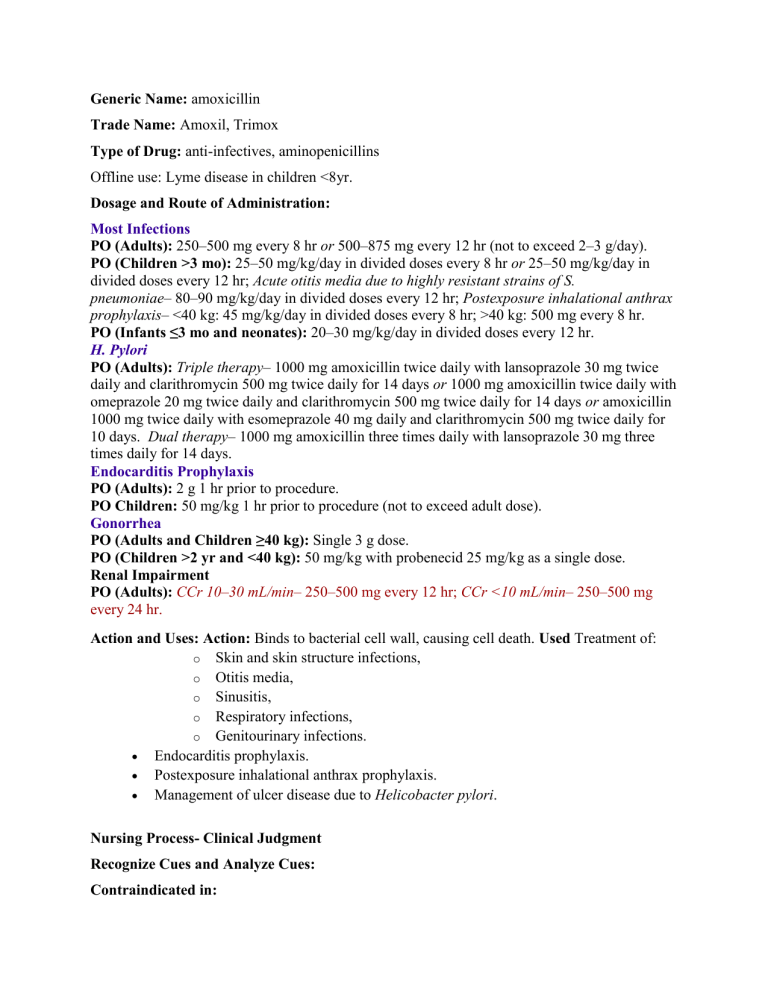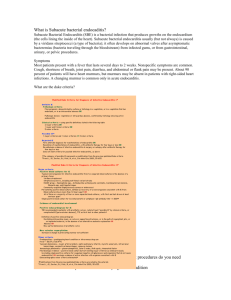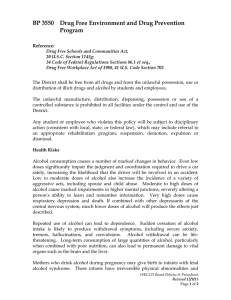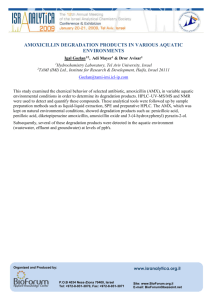
Generic Name: amoxicillin Trade Name: Amoxil, Trimox Type of Drug: anti-infectives, aminopenicillins Offline use: Lyme disease in children <8yr. Dosage and Route of Administration: Most Infections PO (Adults): 250–500 mg every 8 hr or 500–875 mg every 12 hr (not to exceed 2–3 g/day). PO (Children >3 mo): 25–50 mg/kg/day in divided doses every 8 hr or 25–50 mg/kg/day in divided doses every 12 hr; Acute otitis media due to highly resistant strains of S. pneumoniae– 80–90 mg/kg/day in divided doses every 12 hr; Postexposure inhalational anthrax prophylaxis– <40 kg: 45 mg/kg/day in divided doses every 8 hr; >40 kg: 500 mg every 8 hr. PO (Infants ≤3 mo and neonates): 20–30 mg/kg/day in divided doses every 12 hr. H. Pylori PO (Adults): Triple therapy– 1000 mg amoxicillin twice daily with lansoprazole 30 mg twice daily and clarithromycin 500 mg twice daily for 14 days or 1000 mg amoxicillin twice daily with omeprazole 20 mg twice daily and clarithromycin 500 mg twice daily for 14 days or amoxicillin 1000 mg twice daily with esomeprazole 40 mg daily and clarithromycin 500 mg twice daily for 10 days. Dual therapy– 1000 mg amoxicillin three times daily with lansoprazole 30 mg three times daily for 14 days. Endocarditis Prophylaxis PO (Adults): 2 g 1 hr prior to procedure. PO Children: 50 mg/kg 1 hr prior to procedure (not to exceed adult dose). Gonorrhea PO (Adults and Children ≥40 kg): Single 3 g dose. PO (Children >2 yr and <40 kg): 50 mg/kg with probenecid 25 mg/kg as a single dose. Renal Impairment PO (Adults): CCr 10–30 mL/min– 250–500 mg every 12 hr; CCr <10 mL/min– 250–500 mg every 24 hr. Action and Uses: Action: Binds to bacterial cell wall, causing cell death. Used Treatment of: o Skin and skin structure infections, o Otitis media, o Sinusitis, o Respiratory infections, o Genitourinary infections. Endocarditis prophylaxis. Postexposure inhalational anthrax prophylaxis. Management of ulcer disease due to Helicobacter pylori. Nursing Process- Clinical Judgment Recognize Cues and Analyze Cues: Contraindicated in: Hypersensitivity to penicillins (cross-sensitivity exists to cephalosporins and other beta-lactams). Use Cautiously in: Severe renal impairment (↓ dose if CCr <30 mL/min); Infectious mononucleosis, acute lymphocytic leukemia, or cytomegalovirus infection (↑ risk of rash); OB: Lactation: Has been used safely Prioritize Hypothesis: *List priority hypothesis that can occur when taking drug* Take action/Interventions: Adverse Reaction: Derm: rash, urticaria GI: CLOSTRIDIOIDES DIFFICILE-ASSOCIATED DIARRHEA (CDAD), diarrhea, nausea, vomiting, ↑ liver enzymes Hemat: blood dyscrasias Neuro: SEIZURES (HIGH DOSES) Misc: HYPERSENSITIVITY REACTIONS (INCLUDING ANAPHYLAXIS), SERUM SICKNESS, superinfection Assessment: Assess for infection (vital signs; appearance of wound, sputum, urine, and stool; WBC) at beginning of and throughout therapy. Obtain a history before initiating therapy to determine previous use of and reactions to penicillins or cephalosporins. Persons with a negative history of penicillin sensitivity may still have an allergic response. Monitor for signs and symptoms of anaphylaxis (rash, pruritus, laryngeal edema, wheezing). Notify health care professional immediately if these occur. Obtain specimens for culture and sensitivity prior to therapy. First dose may be given before receiving results. Monitor bowel function. Diarrhea, abdominal cramping, fever, and bloody stools should be reported to health care professional promptly as a sign of Clostridioides difficile-associated diarrhea (CDAD). May begin up to several wk following cessation of therapy. Lab Test Consideration: May cause ↑ serum alkaline phosphatase, LDH, AST, and ALT concentrations. May cause false-positive direct Coombs' test result. Health Education: Instruct patients to take medication around the clock and to finish the drug completely as directed, even if feeling better. Advise patients that sharing of this medication may be dangerous. Pedi: Teach parents or caregivers to calculate and measure doses accurately. Reinforce importance of using measuring device supplied by pharmacy or with product, not household items. Advise patient to report the signs of superinfection (furry overgrowth on the tongue, vaginal itching or discharge, loose or foul-smelling stools) and allergy. Instruct patient to notify health care professional immediately if diarrhea, abdominal cramping, fever, or bloody stools occur and not to treat with antidiarrheals without consulting health care professional. Instruct the patient to notify health care professional if symptoms do not improve. Teach patients with a history of rheumatic heart disease or valve replacement the importance of using antimicrobial prophylaxis before invasive medical or dental procedures. Rep: Caution female patients taking oral contraceptives to use an alternate or additional nonhormonal method of contraception during therapy with amoxicillin and until next menstrual period. Evaluation: Resolution of the signs and symptoms of infection. Length of time for complete resolution depends on the organism and site of infection. Endocarditis prophylaxis. Eradication of H. pylori with resolution of ulcer symptoms. Prevention of inhalational anthrax (postexposure).


